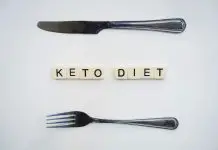A keto calculator to calculate calories and keto macros ratio.
The ketogenic diet is a high-fat, adequate-protein, low-carbohydrate diet that enables the body to burn fats rather than carbohydrates for energy. Read more on ketosis.
Use our Keto calculator to calculate your daily calorie intake, macro-nutrients ratios and your BMR.
The keto calculator is also the easiest way for you to see and monitor the different signs of ketosis. That way, you can check whether or not the diet is working effectively.
Keto calculator
[keto_calculator]
What is ketone diet
The ketone diet and its many varieties have recently become more and more popular, and the reason can be attributed primarily to their (quick) effectiveness in the loss of excess kilograms (fat). In ketone diet carbohydrates represent a very low proportion of macronutrients consumed daily with food.
The ketogenic diet is a high-fat, adequate-protein, low-carbohydrate diet that enables the body to burn fats rather than carbohydrates for energy.
Where does the name ketone diet come from?
Ketosis is a biochemical process in which the body breaks down fatty acids to ketones. Ketones are produced when the body does not have the carbohydrate available and ketones become the main source of energy.
To reach the state of ketosis, the daily intake of carbohydrates should be limited to 50 grams or lower.
Glucose or ketones?
The human body can use glucose or ketones for energy. It is important to know that ketones satisfy the energy needs of the body in the same way as glucose. Forget the myth that carbohydrates are indispensable for energy! The human body does not need a gram of carbohydrates for survival, while fat and protein are essential for its existence.
How to make a Ketone diet menu?
In general, a typical Keto diet should contain about 75-80% fat, 10-15% protein and 5-10% carbohydrates.
A sample Keto menu
Here is an example of how should a keto meal look like: 150g of salmon, 200g of chard and a salad bowl. Of course you can get more creative with the food, but the main point is to include lots of fat, some notable amount of protein and little cabrohydrates. There are no other limitations.

Keto diet should be mainly composed of fat, the protein intake should be approximately 1 g / kg of body weight, and carbohydrates should add up to 50 g per day.
Eat when you’re hungry, but really only when you feel hungry.
Basic Foods for Ketone Diet
Starting with the ketone diet can seem complicated at first, especially in figuring out what you can and cannot eat. Surely, you’ll need to make a few changes with your usual grocery list, so you can comply with the demands of a ketone diet.
- different meat (it can be lean meat or meat with more fat content). This is a staple when you start with your keto diet. These are very rich in protein, which is necessary for preserving muscle mass in a low-carb diet. As much as possible, however, choose grass-fed meat as these are richer in antioxidants. You can find easily these in your local market.
- prosciutto, bacon, greaves
- butter, pork fat, beef tallow
- eggs with yolk, preferably of free-range hen,
- fish and seafood, in particular salmon, mackerel and sardines. These are the most keto-friendly options. Salmon, for instance, is rich in B vitamins but is carb-free. Fatty fish is also rich in omega-3 fats, which can help lower insulin levels. This works best for diabetic patients that are starting with the keto diet.
- vegetables (broccoli, cauliflower, cabbage, kale, spinach, shrimp, cucumbers, peppers, asparagus, courgettes, mushrooms, olives, avocados). These are low in calories and carbs but are very rich in nutrients. Vegetables also give you a balanced diet even while on the keto diet as they’re rich in antioxidants. These can also help combat free radicals that can cause cell damage.
- olive and coconut oil,
- berries.
The choice of food is wide as opposed to other diets that prohibit many foods. With ketone diet, only sugar and starchy foods, that is, those that contain a lot of carbohydrates, should be excluded.
With this list of basic foods, the next step is to plan your meals. If you’re still at a loss as to where and how to start, it also helps to ask advice from a nutritionist.
Health benefits of Ketone Diet
Starting with a ketone diet isn’t just a fad or something that you should do because everyone else is on the boat. It’s always a good way for you to be on board with a healthier lifestyle. The ketone diet has many health benefits, including:
- increased concentration and mental capacity,
- improved physical capacity,
- reduction of blood sugar and insulin levels,
- improved cholesterol levels,
- improvemed health for diabetics,
- prevents the onset of Alzheimer’s disease,
- helps in the treatment of cancer.
Conclusion
The ketogenic diet is a low-carb and high-fat diet that’s set to bring in so many benefits to the individual taking it. Many have sworn by this diet because of its success in helping them improve their overall health through losing weight.
With this keto calculator and all of the information you’ve learned about it, you can be more confident about starting this healthy lifestyle. However, the best word of caution for you to remember is to take advice from a health professional whenever possible and whenever you’re unsure.




































